Monarch Institute: Corporations and Trusts Law Project FNSTPB504
VerifiedAdded on 2023/01/17
|56
|10554
|85
Project
AI Summary
This project delves into the application of legal principles in corporations and trust law, specifically focusing on the unit FNSTPB504. It addresses key areas such as negligence, the elements required to establish it, and risk management practices for tax practitioners. The project includes a case study on pure economic loss, referencing the Fortuna Seafoods case. Furthermore, it examines the factors involved in choosing an appropriate business structure, analyzing scenarios related to partnership agreements and the implications of exceeding purchase limits. The assessment covers various aspects of business law, from understanding negligence and its implications to the practical considerations of forming and managing business structures, including the legal ramifications of partnership agreements and the importance of adhering to established protocols.
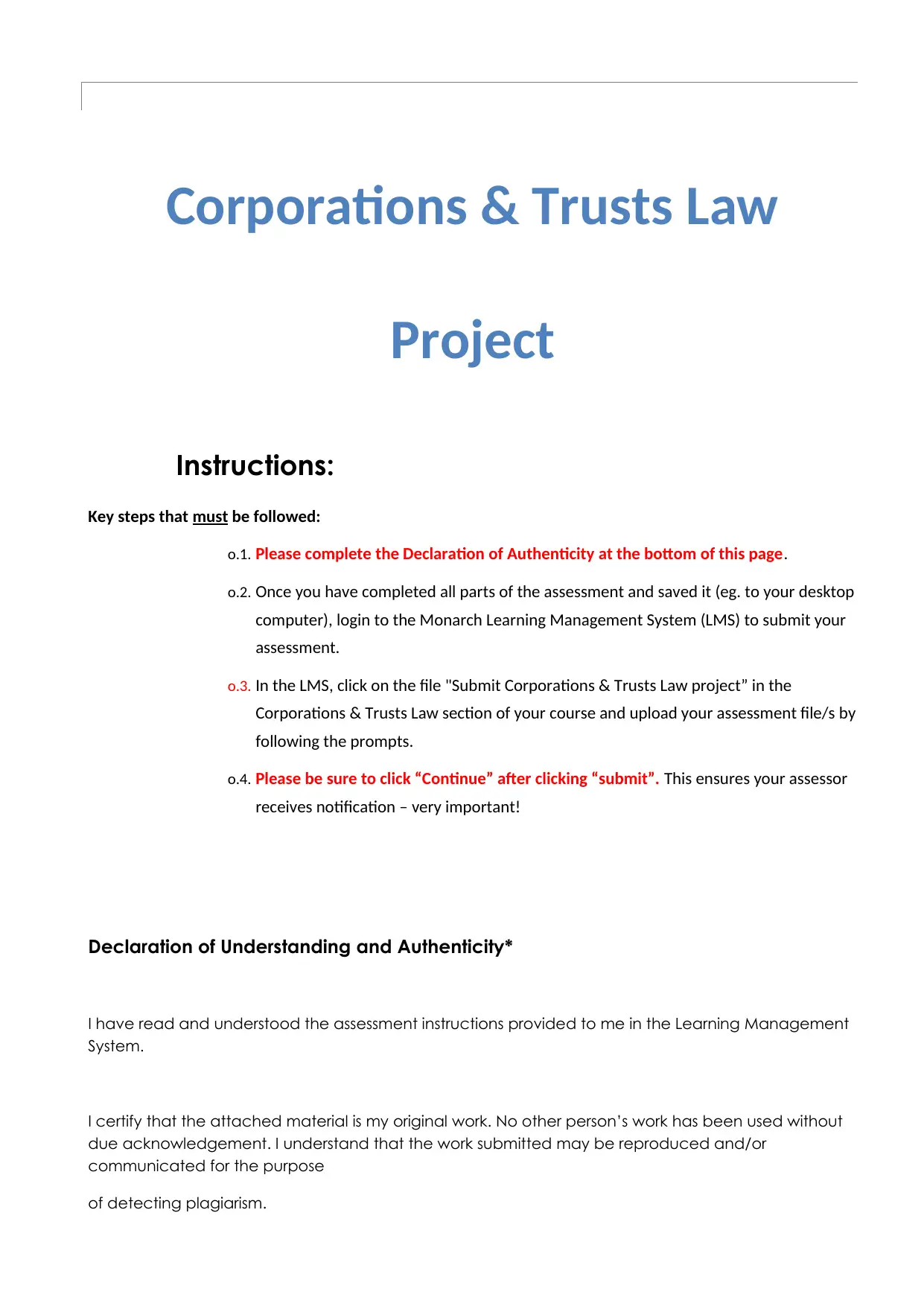
Corporations & Trusts Law
Project
Instructions:
Key steps that must be followed:
o.1. Please complete the Declaration of Authenticity at the bottom of this page.
o.2. Once you have completed all parts of the assessment and saved it (eg. to your desktop
computer), login to the Monarch Learning Management System (LMS) to submit your
assessment.
o.3. In the LMS, click on the file "Submit Corporations & Trusts Law project” in the
Corporations & Trusts Law section of your course and upload your assessment file/s by
following the prompts.
o.4. Please be sure to click “Continue” after clicking “submit”. This ensures your assessor
receives notification – very important!
Declaration of Understanding and Authenticity*
I have read and understood the assessment instructions provided to me in the Learning Management
System.
I certify that the attached material is my original work. No other person’s work has been used without
due acknowledgement. I understand that the work submitted may be reproduced and/or
communicated for the purpose
of detecting plagiarism.
Project
Instructions:
Key steps that must be followed:
o.1. Please complete the Declaration of Authenticity at the bottom of this page.
o.2. Once you have completed all parts of the assessment and saved it (eg. to your desktop
computer), login to the Monarch Learning Management System (LMS) to submit your
assessment.
o.3. In the LMS, click on the file "Submit Corporations & Trusts Law project” in the
Corporations & Trusts Law section of your course and upload your assessment file/s by
following the prompts.
o.4. Please be sure to click “Continue” after clicking “submit”. This ensures your assessor
receives notification – very important!
Declaration of Understanding and Authenticity*
I have read and understood the assessment instructions provided to me in the Learning Management
System.
I certify that the attached material is my original work. No other person’s work has been used without
due acknowledgement. I understand that the work submitted may be reproduced and/or
communicated for the purpose
of detecting plagiarism.
Paraphrase This Document
Need a fresh take? Get an instant paraphrase of this document with our AI Paraphraser

Student Name*: Date:
* I understand that by
typing my name or inserting a digital signature into this box that I agree and
am bound by the above student declaration.
* I understand that by
typing my name or inserting a digital signature into this box that I agree and
am bound by the above student declaration.
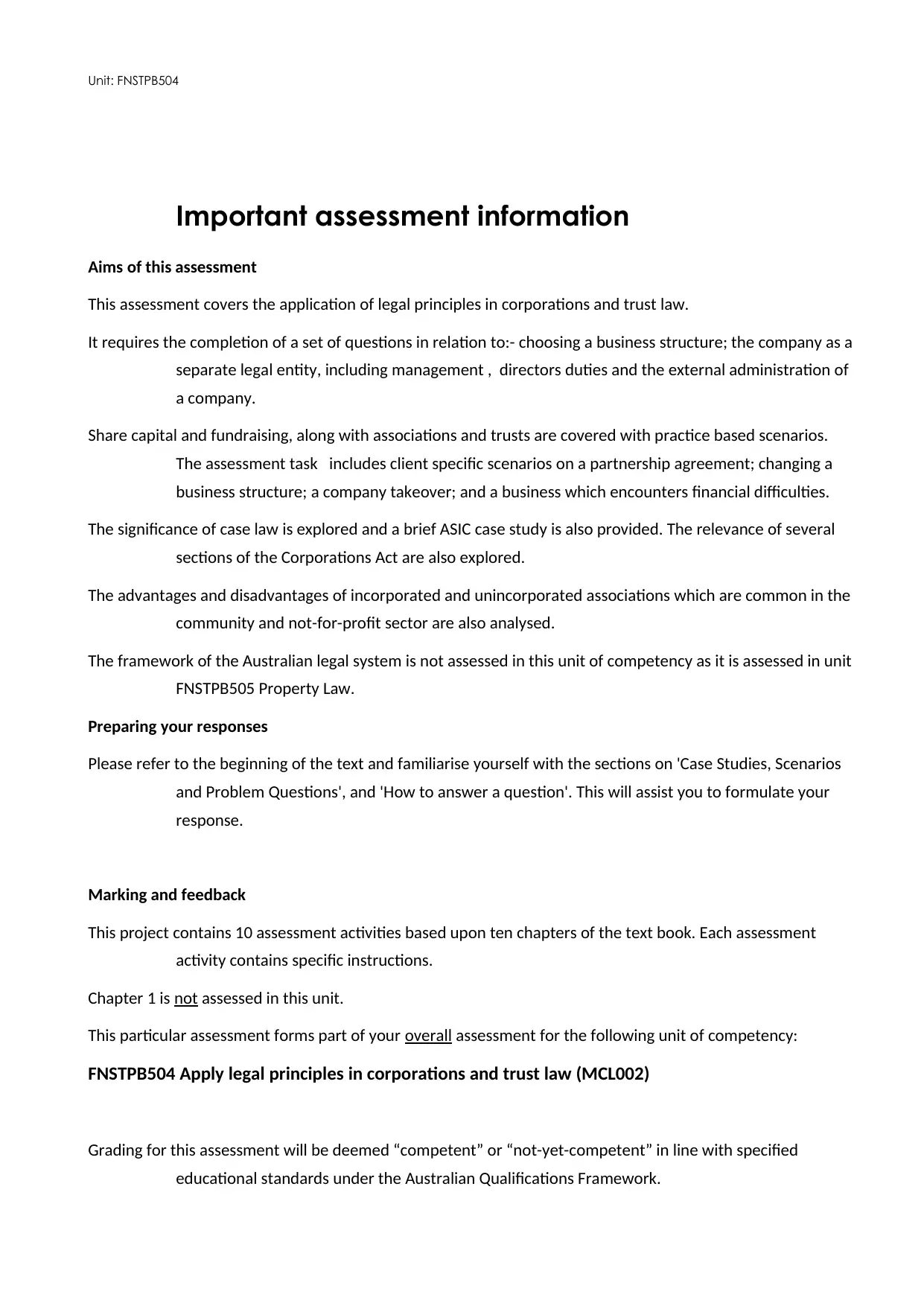
Unit: FNSTPB504
Important assessment information
Aims of this assessment
This assessment covers the application of legal principles in corporations and trust law.
It requires the completion of a set of questions in relation to:- choosing a business structure; the company as a
separate legal entity, including management , directors duties and the external administration of
a company.
Share capital and fundraising, along with associations and trusts are covered with practice based scenarios.
The assessment task includes client specific scenarios on a partnership agreement; changing a
business structure; a company takeover; and a business which encounters financial difficulties.
The significance of case law is explored and a brief ASIC case study is also provided. The relevance of several
sections of the Corporations Act are also explored.
The advantages and disadvantages of incorporated and unincorporated associations which are common in the
community and not-for-profit sector are also analysed.
The framework of the Australian legal system is not assessed in this unit of competency as it is assessed in unit
FNSTPB505 Property Law.
Preparing your responses
Please refer to the beginning of the text and familiarise yourself with the sections on 'Case Studies, Scenarios
and Problem Questions', and 'How to answer a question'. This will assist you to formulate your
response.
Marking and feedback
This project contains 10 assessment activities based upon ten chapters of the text book. Each assessment
activity contains specific instructions.
Chapter 1 is not assessed in this unit.
This particular assessment forms part of your overall assessment for the following unit of competency:
FNSTPB504 Apply legal principles in corporations and trust law (MCL002)
Grading for this assessment will be deemed “competent” or “not-yet-competent” in line with specified
educational standards under the Australian Qualifications Framework.
Important assessment information
Aims of this assessment
This assessment covers the application of legal principles in corporations and trust law.
It requires the completion of a set of questions in relation to:- choosing a business structure; the company as a
separate legal entity, including management , directors duties and the external administration of
a company.
Share capital and fundraising, along with associations and trusts are covered with practice based scenarios.
The assessment task includes client specific scenarios on a partnership agreement; changing a
business structure; a company takeover; and a business which encounters financial difficulties.
The significance of case law is explored and a brief ASIC case study is also provided. The relevance of several
sections of the Corporations Act are also explored.
The advantages and disadvantages of incorporated and unincorporated associations which are common in the
community and not-for-profit sector are also analysed.
The framework of the Australian legal system is not assessed in this unit of competency as it is assessed in unit
FNSTPB505 Property Law.
Preparing your responses
Please refer to the beginning of the text and familiarise yourself with the sections on 'Case Studies, Scenarios
and Problem Questions', and 'How to answer a question'. This will assist you to formulate your
response.
Marking and feedback
This project contains 10 assessment activities based upon ten chapters of the text book. Each assessment
activity contains specific instructions.
Chapter 1 is not assessed in this unit.
This particular assessment forms part of your overall assessment for the following unit of competency:
FNSTPB504 Apply legal principles in corporations and trust law (MCL002)
Grading for this assessment will be deemed “competent” or “not-yet-competent” in line with specified
educational standards under the Australian Qualifications Framework.
⊘ This is a preview!⊘
Do you want full access?
Subscribe today to unlock all pages.

Trusted by 1+ million students worldwide
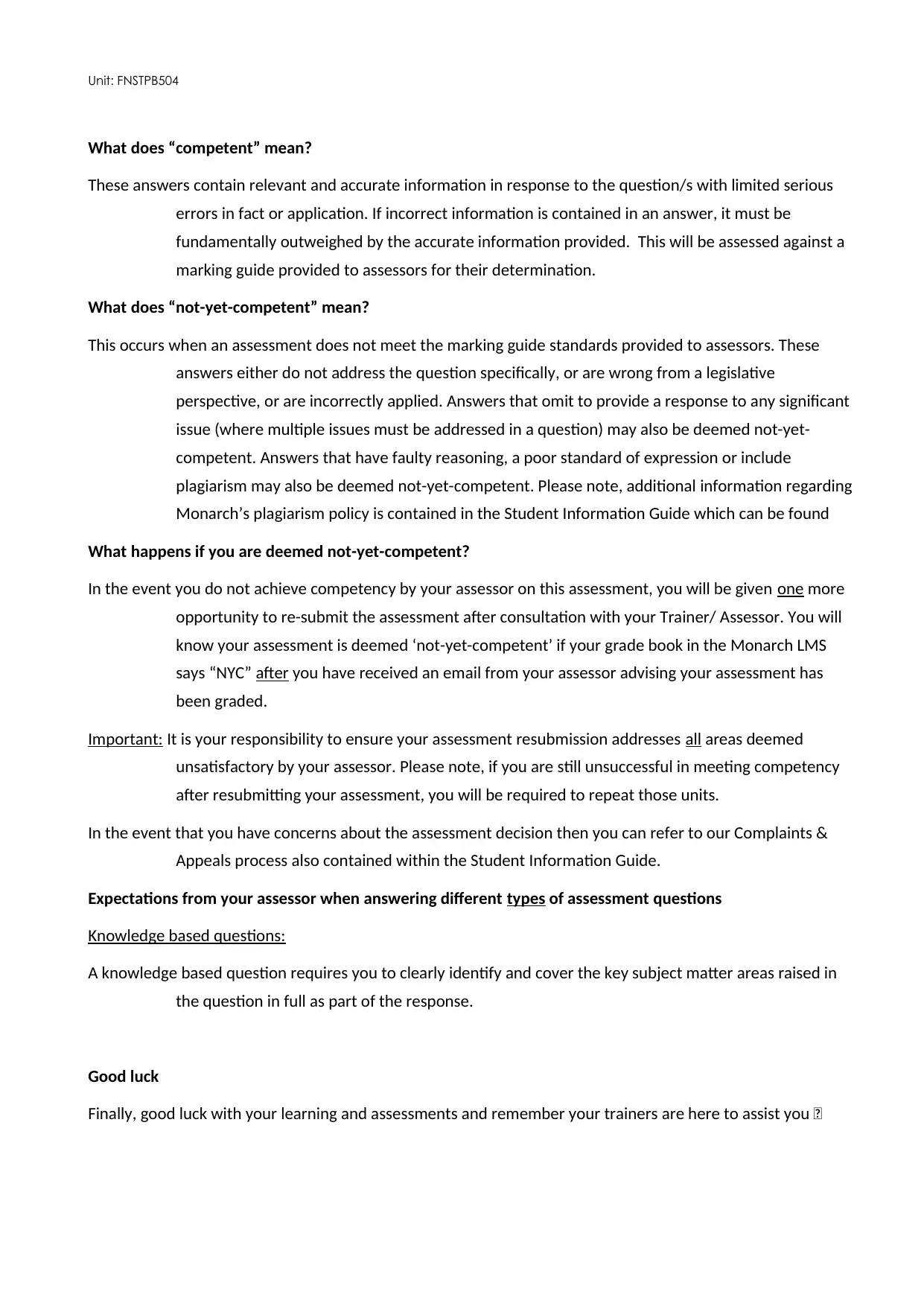
Unit: FNSTPB504
What does “competent” mean?
These answers contain relevant and accurate information in response to the question/s with limited serious
errors in fact or application. If incorrect information is contained in an answer, it must be
fundamentally outweighed by the accurate information provided. This will be assessed against a
marking guide provided to assessors for their determination.
What does “not-yet-competent” mean?
This occurs when an assessment does not meet the marking guide standards provided to assessors. These
answers either do not address the question specifically, or are wrong from a legislative
perspective, or are incorrectly applied. Answers that omit to provide a response to any significant
issue (where multiple issues must be addressed in a question) may also be deemed not-yet-
competent. Answers that have faulty reasoning, a poor standard of expression or include
plagiarism may also be deemed not-yet-competent. Please note, additional information regarding
Monarch’s plagiarism policy is contained in the Student Information Guide which can be found
What happens if you are deemed not-yet-competent?
In the event you do not achieve competency by your assessor on this assessment, you will be given one more
opportunity to re-submit the assessment after consultation with your Trainer/ Assessor. You will
know your assessment is deemed ‘not-yet-competent’ if your grade book in the Monarch LMS
says “NYC” after you have received an email from your assessor advising your assessment has
been graded.
Important: It is your responsibility to ensure your assessment resubmission addresses all areas deemed
unsatisfactory by your assessor. Please note, if you are still unsuccessful in meeting competency
after resubmitting your assessment, you will be required to repeat those units.
In the event that you have concerns about the assessment decision then you can refer to our Complaints &
Appeals process also contained within the Student Information Guide.
Expectations from your assessor when answering different types of assessment questions
Knowledge based questions:
A knowledge based question requires you to clearly identify and cover the key subject matter areas raised in
the question in full as part of the response.
Good luck
Finally, good luck with your learning and assessments and remember your trainers are here to assist you
What does “competent” mean?
These answers contain relevant and accurate information in response to the question/s with limited serious
errors in fact or application. If incorrect information is contained in an answer, it must be
fundamentally outweighed by the accurate information provided. This will be assessed against a
marking guide provided to assessors for their determination.
What does “not-yet-competent” mean?
This occurs when an assessment does not meet the marking guide standards provided to assessors. These
answers either do not address the question specifically, or are wrong from a legislative
perspective, or are incorrectly applied. Answers that omit to provide a response to any significant
issue (where multiple issues must be addressed in a question) may also be deemed not-yet-
competent. Answers that have faulty reasoning, a poor standard of expression or include
plagiarism may also be deemed not-yet-competent. Please note, additional information regarding
Monarch’s plagiarism policy is contained in the Student Information Guide which can be found
What happens if you are deemed not-yet-competent?
In the event you do not achieve competency by your assessor on this assessment, you will be given one more
opportunity to re-submit the assessment after consultation with your Trainer/ Assessor. You will
know your assessment is deemed ‘not-yet-competent’ if your grade book in the Monarch LMS
says “NYC” after you have received an email from your assessor advising your assessment has
been graded.
Important: It is your responsibility to ensure your assessment resubmission addresses all areas deemed
unsatisfactory by your assessor. Please note, if you are still unsuccessful in meeting competency
after resubmitting your assessment, you will be required to repeat those units.
In the event that you have concerns about the assessment decision then you can refer to our Complaints &
Appeals process also contained within the Student Information Guide.
Expectations from your assessor when answering different types of assessment questions
Knowledge based questions:
A knowledge based question requires you to clearly identify and cover the key subject matter areas raised in
the question in full as part of the response.
Good luck
Finally, good luck with your learning and assessments and remember your trainers are here to assist you
Paraphrase This Document
Need a fresh take? Get an instant paraphrase of this document with our AI Paraphraser
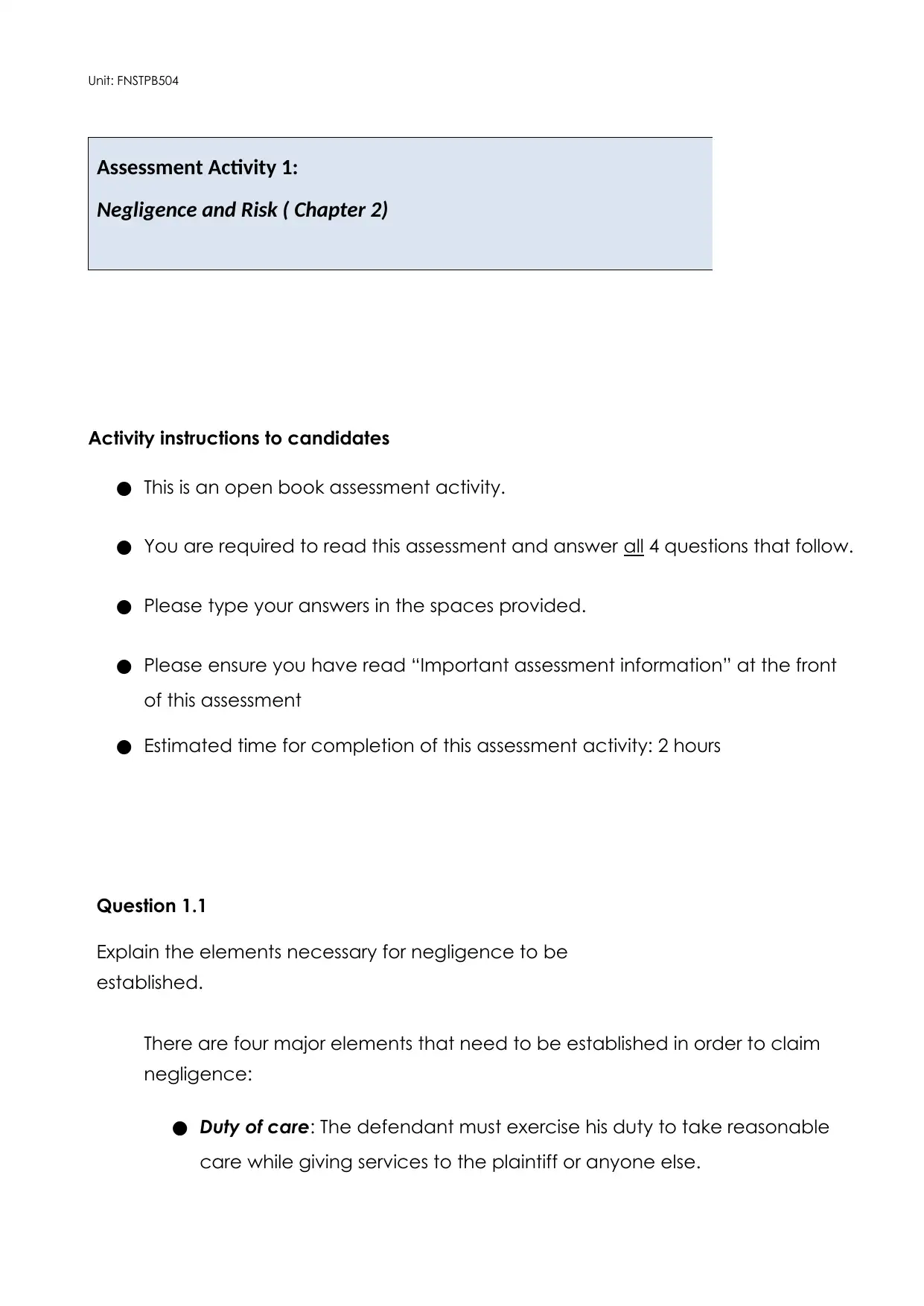
Unit: FNSTPB504
Assessment Activity 1:
Negligence and Risk ( Chapter 2)
Activity instructions to candidates
● This is an open book assessment activity.
● You are required to read this assessment and answer all 4 questions that follow.
● Please type your answers in the spaces provided.
● Please ensure you have read “Important assessment information” at the front
of this assessment
● Estimated time for completion of this assessment activity: 2 hours
Question 1.1
Explain the elements necessary for negligence to be
established.
There are four major elements that need to be established in order to claim
negligence:
● Duty of care: The defendant must exercise his duty to take reasonable
care while giving services to the plaintiff or anyone else.
Assessment Activity 1:
Negligence and Risk ( Chapter 2)
Activity instructions to candidates
● This is an open book assessment activity.
● You are required to read this assessment and answer all 4 questions that follow.
● Please type your answers in the spaces provided.
● Please ensure you have read “Important assessment information” at the front
of this assessment
● Estimated time for completion of this assessment activity: 2 hours
Question 1.1
Explain the elements necessary for negligence to be
established.
There are four major elements that need to be established in order to claim
negligence:
● Duty of care: The defendant must exercise his duty to take reasonable
care while giving services to the plaintiff or anyone else.
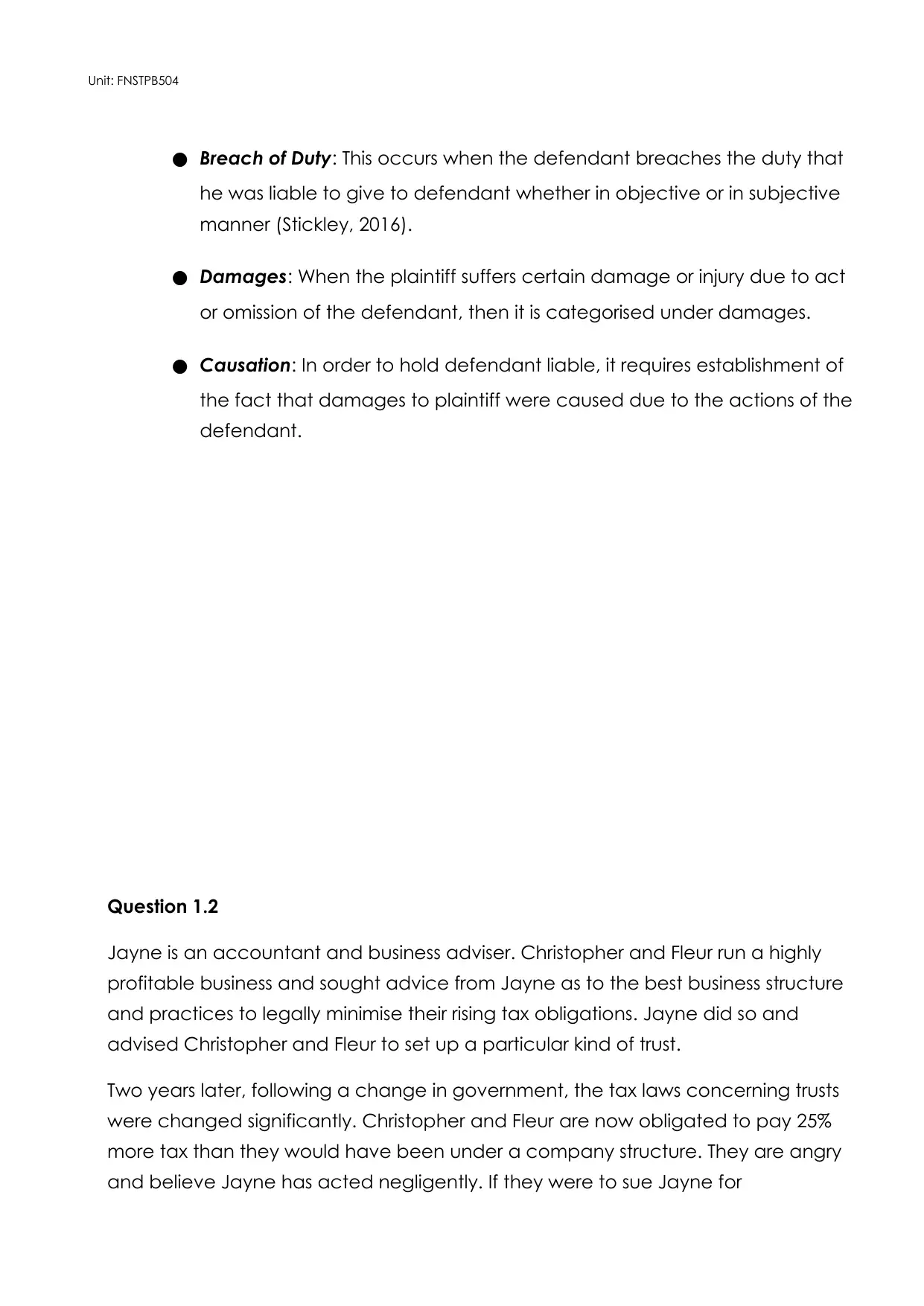
Unit: FNSTPB504
● Breach of Duty: This occurs when the defendant breaches the duty that
he was liable to give to defendant whether in objective or in subjective
manner (Stickley, 2016).
● Damages: When the plaintiff suffers certain damage or injury due to act
or omission of the defendant, then it is categorised under damages.
● Causation: In order to hold defendant liable, it requires establishment of
the fact that damages to plaintiff were caused due to the actions of the
defendant.
Question 1.2
Jayne is an accountant and business adviser. Christopher and Fleur run a highly
profitable business and sought advice from Jayne as to the best business structure
and practices to legally minimise their rising tax obligations. Jayne did so and
advised Christopher and Fleur to set up a particular kind of trust.
Two years later, following a change in government, the tax laws concerning trusts
were changed significantly. Christopher and Fleur are now obligated to pay 25%
more tax than they would have been under a company structure. They are angry
and believe Jayne has acted negligently. If they were to sue Jayne for
● Breach of Duty: This occurs when the defendant breaches the duty that
he was liable to give to defendant whether in objective or in subjective
manner (Stickley, 2016).
● Damages: When the plaintiff suffers certain damage or injury due to act
or omission of the defendant, then it is categorised under damages.
● Causation: In order to hold defendant liable, it requires establishment of
the fact that damages to plaintiff were caused due to the actions of the
defendant.
Question 1.2
Jayne is an accountant and business adviser. Christopher and Fleur run a highly
profitable business and sought advice from Jayne as to the best business structure
and practices to legally minimise their rising tax obligations. Jayne did so and
advised Christopher and Fleur to set up a particular kind of trust.
Two years later, following a change in government, the tax laws concerning trusts
were changed significantly. Christopher and Fleur are now obligated to pay 25%
more tax than they would have been under a company structure. They are angry
and believe Jayne has acted negligently. If they were to sue Jayne for
⊘ This is a preview!⊘
Do you want full access?
Subscribe today to unlock all pages.

Trusted by 1+ million students worldwide
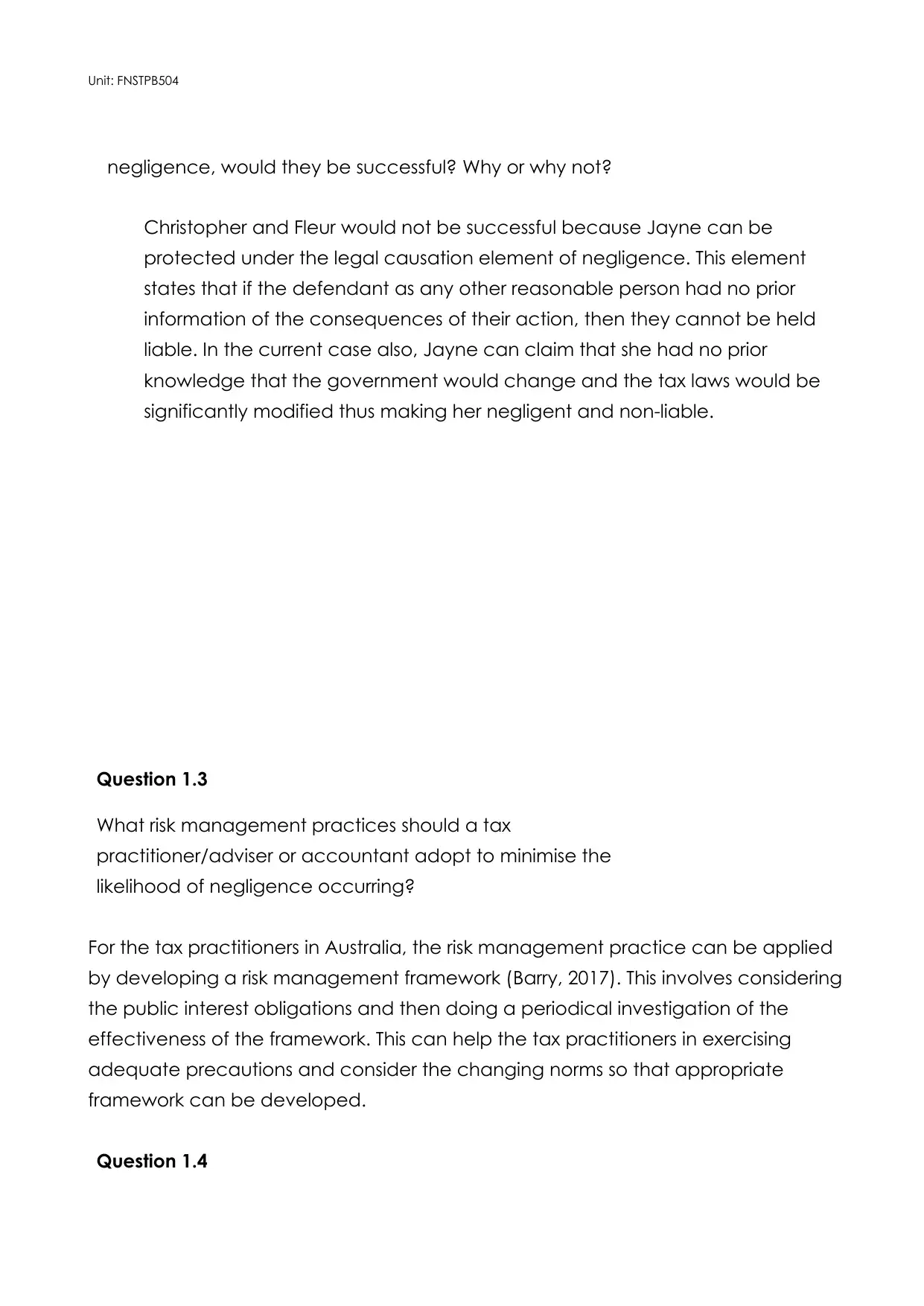
Unit: FNSTPB504
negligence, would they be successful? Why or why not?
Christopher and Fleur would not be successful because Jayne can be
protected under the legal causation element of negligence. This element
states that if the defendant as any other reasonable person had no prior
information of the consequences of their action, then they cannot be held
liable. In the current case also, Jayne can claim that she had no prior
knowledge that the government would change and the tax laws would be
significantly modified thus making her negligent and non-liable.
Question 1.3
What risk management practices should a tax
practitioner/adviser or accountant adopt to minimise the
likelihood of negligence occurring?
For the tax practitioners in Australia, the risk management practice can be applied
by developing a risk management framework (Barry, 2017). This involves considering
the public interest obligations and then doing a periodical investigation of the
effectiveness of the framework. This can help the tax practitioners in exercising
adequate precautions and consider the changing norms so that appropriate
framework can be developed.
Question 1.4
negligence, would they be successful? Why or why not?
Christopher and Fleur would not be successful because Jayne can be
protected under the legal causation element of negligence. This element
states that if the defendant as any other reasonable person had no prior
information of the consequences of their action, then they cannot be held
liable. In the current case also, Jayne can claim that she had no prior
knowledge that the government would change and the tax laws would be
significantly modified thus making her negligent and non-liable.
Question 1.3
What risk management practices should a tax
practitioner/adviser or accountant adopt to minimise the
likelihood of negligence occurring?
For the tax practitioners in Australia, the risk management practice can be applied
by developing a risk management framework (Barry, 2017). This involves considering
the public interest obligations and then doing a periodical investigation of the
effectiveness of the framework. This can help the tax practitioners in exercising
adequate precautions and consider the changing norms so that appropriate
framework can be developed.
Question 1.4
Paraphrase This Document
Need a fresh take? Get an instant paraphrase of this document with our AI Paraphraser
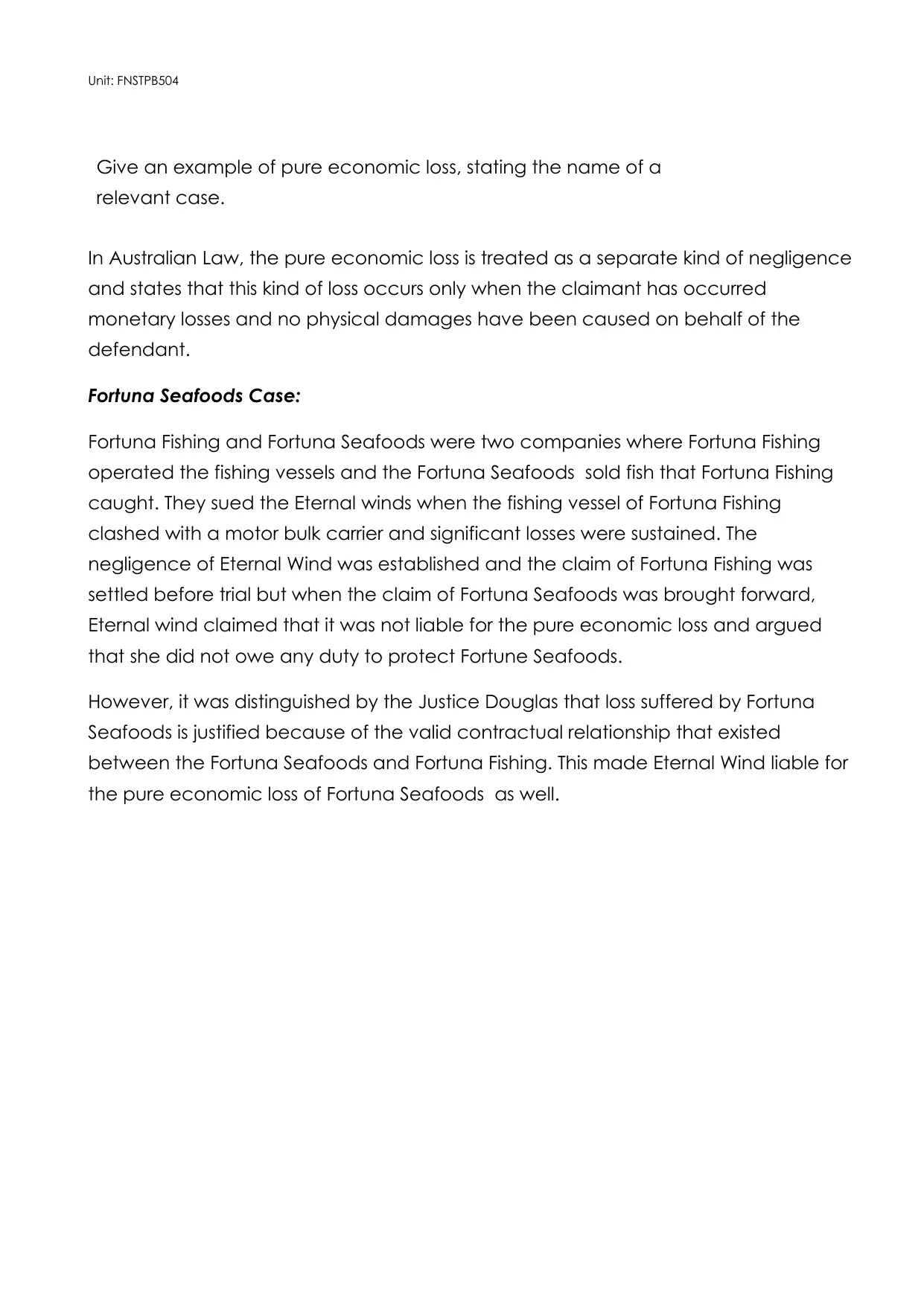
Unit: FNSTPB504
Give an example of pure economic loss, stating the name of a
relevant case.
In Australian Law, the pure economic loss is treated as a separate kind of negligence
and states that this kind of loss occurs only when the claimant has occurred
monetary losses and no physical damages have been caused on behalf of the
defendant.
Fortuna Seafoods Case:
Fortuna Fishing and Fortuna Seafoods were two companies where Fortuna Fishing
operated the fishing vessels and the Fortuna Seafoods sold fish that Fortuna Fishing
caught. They sued the Eternal winds when the fishing vessel of Fortuna Fishing
clashed with a motor bulk carrier and significant losses were sustained. The
negligence of Eternal Wind was established and the claim of Fortuna Fishing was
settled before trial but when the claim of Fortuna Seafoods was brought forward,
Eternal wind claimed that it was not liable for the pure economic loss and argued
that she did not owe any duty to protect Fortune Seafoods.
However, it was distinguished by the Justice Douglas that loss suffered by Fortuna
Seafoods is justified because of the valid contractual relationship that existed
between the Fortuna Seafoods and Fortuna Fishing. This made Eternal Wind liable for
the pure economic loss of Fortuna Seafoods as well.
Give an example of pure economic loss, stating the name of a
relevant case.
In Australian Law, the pure economic loss is treated as a separate kind of negligence
and states that this kind of loss occurs only when the claimant has occurred
monetary losses and no physical damages have been caused on behalf of the
defendant.
Fortuna Seafoods Case:
Fortuna Fishing and Fortuna Seafoods were two companies where Fortuna Fishing
operated the fishing vessels and the Fortuna Seafoods sold fish that Fortuna Fishing
caught. They sued the Eternal winds when the fishing vessel of Fortuna Fishing
clashed with a motor bulk carrier and significant losses were sustained. The
negligence of Eternal Wind was established and the claim of Fortuna Fishing was
settled before trial but when the claim of Fortuna Seafoods was brought forward,
Eternal wind claimed that it was not liable for the pure economic loss and argued
that she did not owe any duty to protect Fortune Seafoods.
However, it was distinguished by the Justice Douglas that loss suffered by Fortuna
Seafoods is justified because of the valid contractual relationship that existed
between the Fortuna Seafoods and Fortuna Fishing. This made Eternal Wind liable for
the pure economic loss of Fortuna Seafoods as well.
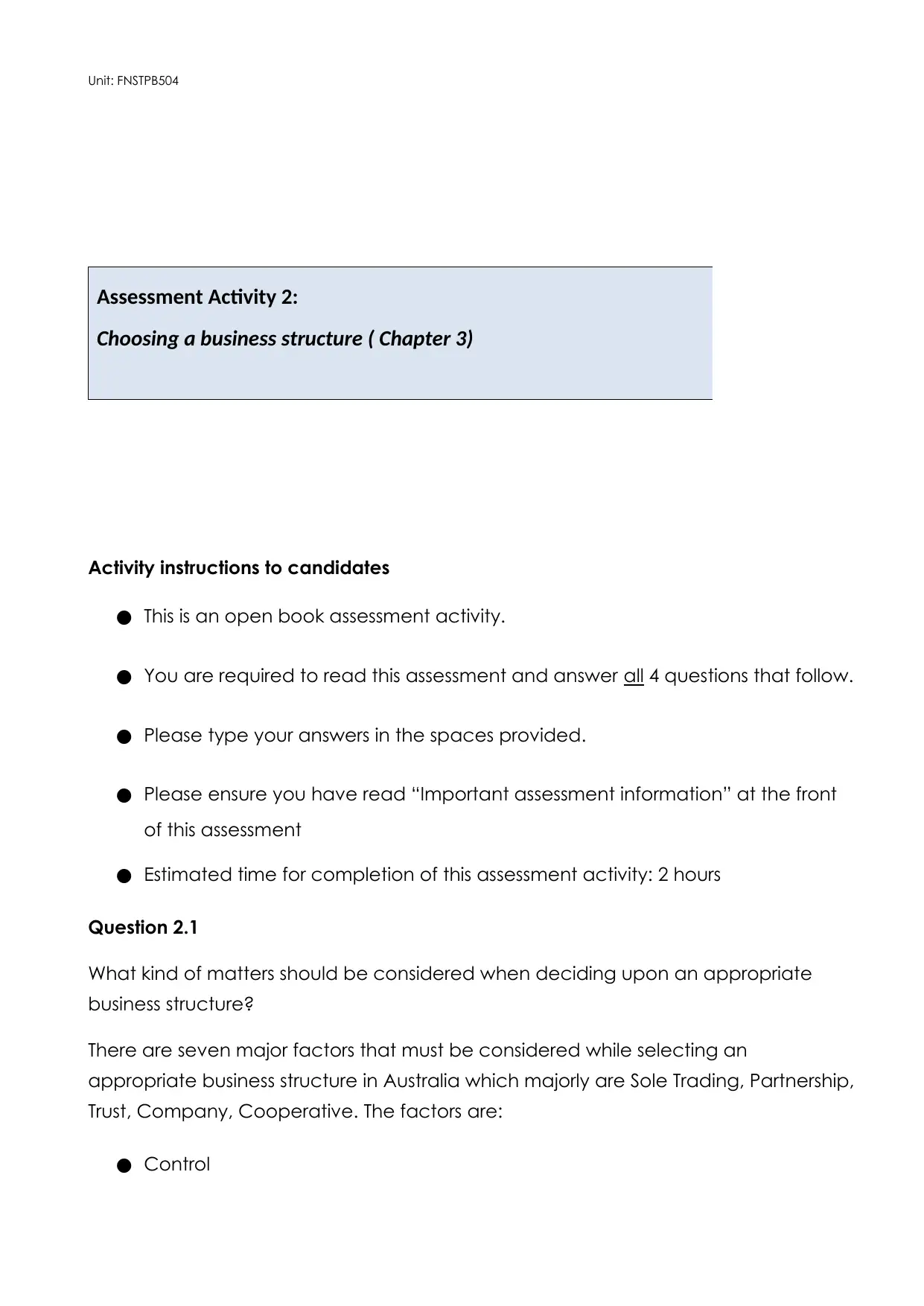
Unit: FNSTPB504
Assessment Activity 2:
Choosing a business structure ( Chapter 3)
Activity instructions to candidates
● This is an open book assessment activity.
● You are required to read this assessment and answer all 4 questions that follow.
● Please type your answers in the spaces provided.
● Please ensure you have read “Important assessment information” at the front
of this assessment
● Estimated time for completion of this assessment activity: 2 hours
Question 2.1
What kind of matters should be considered when deciding upon an appropriate
business structure?
There are seven major factors that must be considered while selecting an
appropriate business structure in Australia which majorly are Sole Trading, Partnership,
Trust, Company, Cooperative. The factors are:
● Control
Assessment Activity 2:
Choosing a business structure ( Chapter 3)
Activity instructions to candidates
● This is an open book assessment activity.
● You are required to read this assessment and answer all 4 questions that follow.
● Please type your answers in the spaces provided.
● Please ensure you have read “Important assessment information” at the front
of this assessment
● Estimated time for completion of this assessment activity: 2 hours
Question 2.1
What kind of matters should be considered when deciding upon an appropriate
business structure?
There are seven major factors that must be considered while selecting an
appropriate business structure in Australia which majorly are Sole Trading, Partnership,
Trust, Company, Cooperative. The factors are:
● Control
⊘ This is a preview!⊘
Do you want full access?
Subscribe today to unlock all pages.

Trusted by 1+ million students worldwide
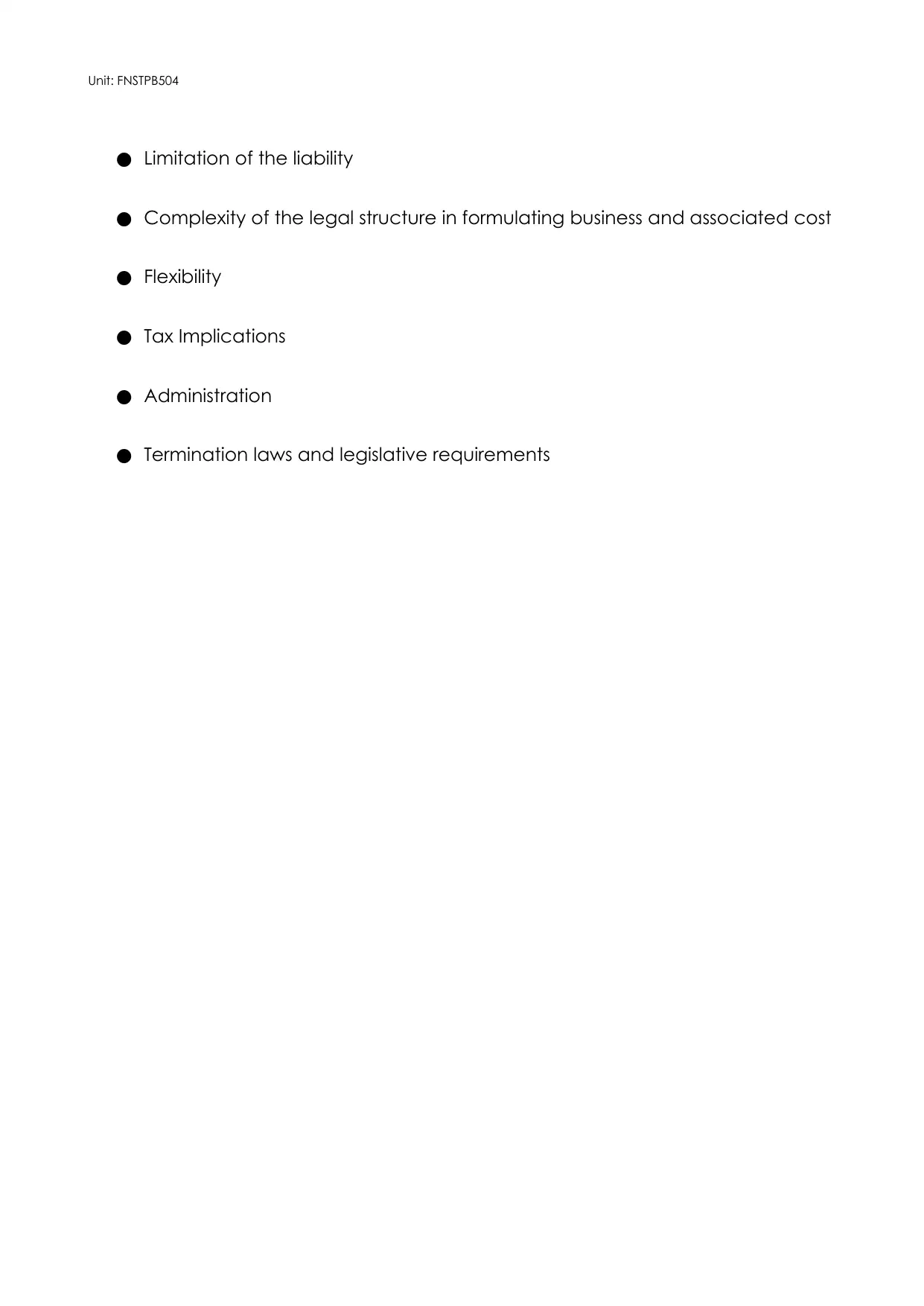
Unit: FNSTPB504
● Limitation of the liability
● Complexity of the legal structure in formulating business and associated cost
● Flexibility
● Tax Implications
● Administration
● Termination laws and legislative requirements
● Limitation of the liability
● Complexity of the legal structure in formulating business and associated cost
● Flexibility
● Tax Implications
● Administration
● Termination laws and legislative requirements
Paraphrase This Document
Need a fresh take? Get an instant paraphrase of this document with our AI Paraphraser
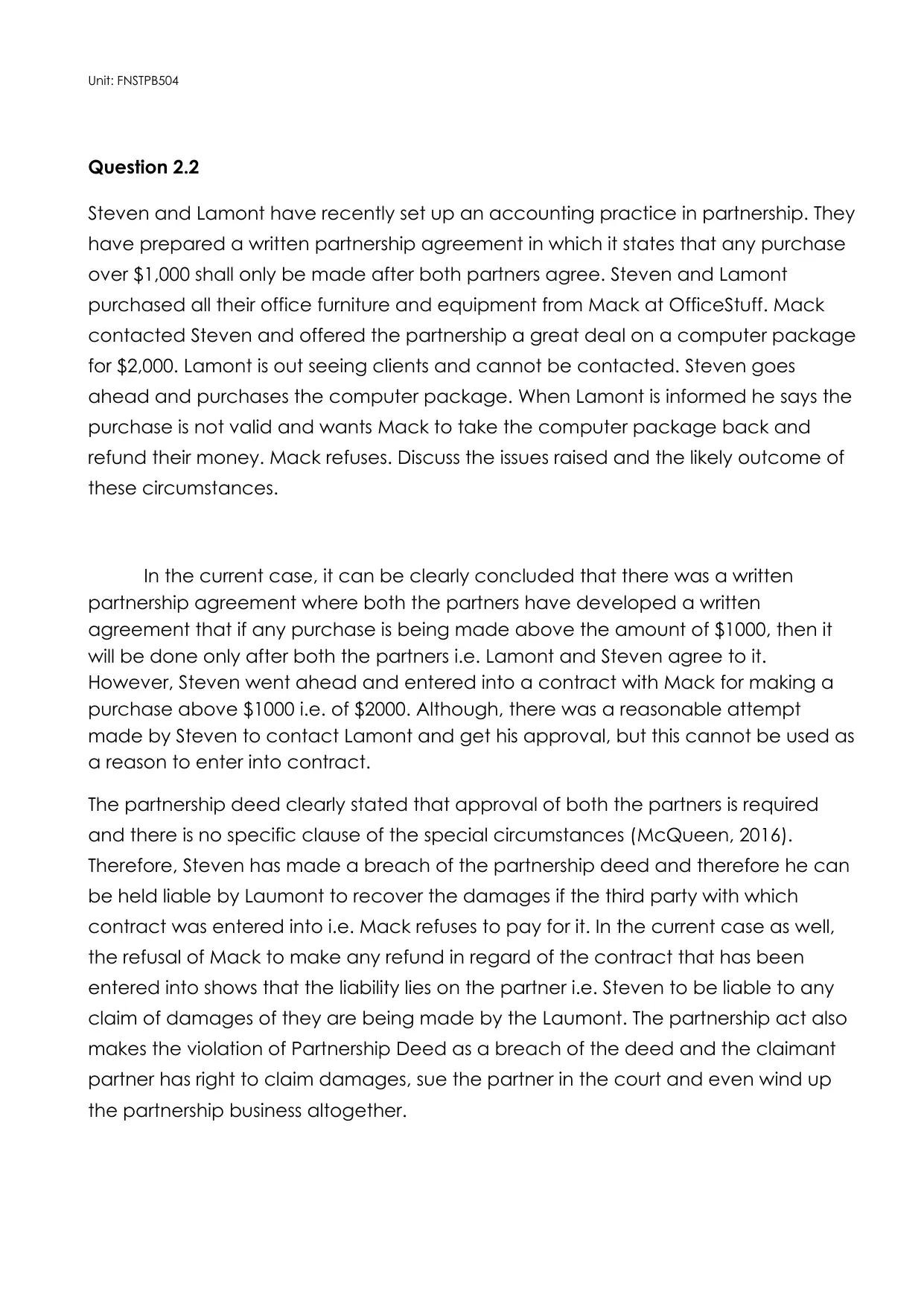
Unit: FNSTPB504
Question 2.2
Steven and Lamont have recently set up an accounting practice in partnership. They
have prepared a written partnership agreement in which it states that any purchase
over $1,000 shall only be made after both partners agree. Steven and Lamont
purchased all their office furniture and equipment from Mack at OfficeStuff. Mack
contacted Steven and offered the partnership a great deal on a computer package
for $2,000. Lamont is out seeing clients and cannot be contacted. Steven goes
ahead and purchases the computer package. When Lamont is informed he says the
purchase is not valid and wants Mack to take the computer package back and
refund their money. Mack refuses. Discuss the issues raised and the likely outcome of
these circumstances.
In the current case, it can be clearly concluded that there was a written
partnership agreement where both the partners have developed a written
agreement that if any purchase is being made above the amount of $1000, then it
will be done only after both the partners i.e. Lamont and Steven agree to it.
However, Steven went ahead and entered into a contract with Mack for making a
purchase above $1000 i.e. of $2000. Although, there was a reasonable attempt
made by Steven to contact Lamont and get his approval, but this cannot be used as
a reason to enter into contract.
The partnership deed clearly stated that approval of both the partners is required
and there is no specific clause of the special circumstances (McQueen, 2016).
Therefore, Steven has made a breach of the partnership deed and therefore he can
be held liable by Laumont to recover the damages if the third party with which
contract was entered into i.e. Mack refuses to pay for it. In the current case as well,
the refusal of Mack to make any refund in regard of the contract that has been
entered into shows that the liability lies on the partner i.e. Steven to be liable to any
claim of damages of they are being made by the Laumont. The partnership act also
makes the violation of Partnership Deed as a breach of the deed and the claimant
partner has right to claim damages, sue the partner in the court and even wind up
the partnership business altogether.
Question 2.2
Steven and Lamont have recently set up an accounting practice in partnership. They
have prepared a written partnership agreement in which it states that any purchase
over $1,000 shall only be made after both partners agree. Steven and Lamont
purchased all their office furniture and equipment from Mack at OfficeStuff. Mack
contacted Steven and offered the partnership a great deal on a computer package
for $2,000. Lamont is out seeing clients and cannot be contacted. Steven goes
ahead and purchases the computer package. When Lamont is informed he says the
purchase is not valid and wants Mack to take the computer package back and
refund their money. Mack refuses. Discuss the issues raised and the likely outcome of
these circumstances.
In the current case, it can be clearly concluded that there was a written
partnership agreement where both the partners have developed a written
agreement that if any purchase is being made above the amount of $1000, then it
will be done only after both the partners i.e. Lamont and Steven agree to it.
However, Steven went ahead and entered into a contract with Mack for making a
purchase above $1000 i.e. of $2000. Although, there was a reasonable attempt
made by Steven to contact Lamont and get his approval, but this cannot be used as
a reason to enter into contract.
The partnership deed clearly stated that approval of both the partners is required
and there is no specific clause of the special circumstances (McQueen, 2016).
Therefore, Steven has made a breach of the partnership deed and therefore he can
be held liable by Laumont to recover the damages if the third party with which
contract was entered into i.e. Mack refuses to pay for it. In the current case as well,
the refusal of Mack to make any refund in regard of the contract that has been
entered into shows that the liability lies on the partner i.e. Steven to be liable to any
claim of damages of they are being made by the Laumont. The partnership act also
makes the violation of Partnership Deed as a breach of the deed and the claimant
partner has right to claim damages, sue the partner in the court and even wind up
the partnership business altogether.

Unit: FNSTPB504
⊘ This is a preview!⊘
Do you want full access?
Subscribe today to unlock all pages.

Trusted by 1+ million students worldwide
1 out of 56
Related Documents
Your All-in-One AI-Powered Toolkit for Academic Success.
+13062052269
info@desklib.com
Available 24*7 on WhatsApp / Email
![[object Object]](/_next/static/media/star-bottom.7253800d.svg)
Unlock your academic potential
Copyright © 2020–2025 A2Z Services. All Rights Reserved. Developed and managed by ZUCOL.





